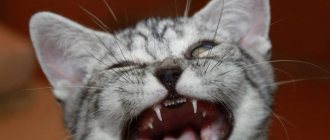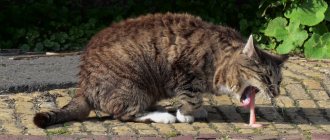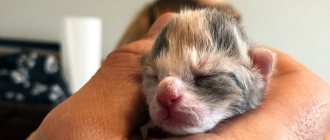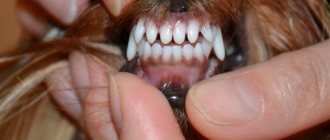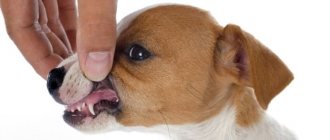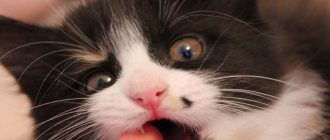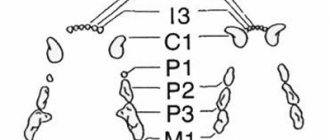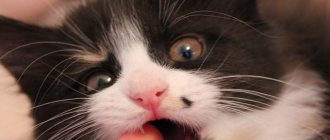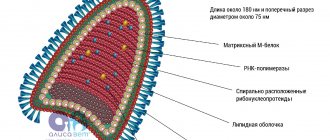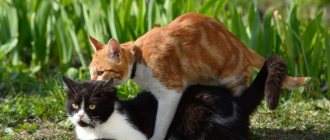When kittens change their milk teeth, owners should pay special attention to their little pet. In some pets, a similar process occurs at the age of 5-6 months, while in others, teeth change for about a year. In rare cases, in lop-eared kittens and representatives of other breeds, tooth replacement occurs painlessly. But often owners notice that when the baby gets new front teeth, the gums itch, there is pain and other unpleasant symptoms.
Owners are advised to contact a veterinarian, who, if necessary, will prescribe medications for the pet to facilitate the process of teething, and suggest other methods to eliminate discomfort.
Why do new teeth emerge?
Just like in humans, kittens 4 months and older gradually replace their milky bone tissue with permanent teeth. Many owners get scared when they notice that the cat is missing one tooth or is constantly scratching its lips and gums. There is no need to worry, since such a process is completely natural and necessary. It is only important to ensure that the animal grows a new set of teeth normally and does not have double teeth, in which two teeth immediately fall out in place of one tooth. Contacting a veterinarian is also necessary in other cases:
- the resulting wounds fester and heal for a long time;
- inflammatory reaction in the gum area.
Diet for a kitten
During the period of bone tissue formation, food should contain a sufficient amount of calcium and fluorine. A lack of mineral elements will cause delayed, uneven tooth replacement. Dry food for kittens contains all the necessary mineral supplements and will be useful as crackers for massaging swollen gums. The kitten may refuse to eat because they are sore, but this may not last long. A cat, as a predator by nature, cannot starve for more than 2 days. A small cat will only be able to skip one feeding. If he continues to starve, then you need to contact your veterinarian.
© shutterstock
Age at which change occurs
The eruption of fangs in kittens occurs two weeks after birth, but some babies are already born with them.
Sometimes milk teeth in cats are observed immediately when they are born, but more often they appear 1-2 weeks after the kitten is born. The first two canines in Scottish cats and representatives of other breeds are observed by 4 weeks of age. Baby teeth in boys and girls can be replaced in different ways, but on average the process of complete replacement ends in six months. In this case, the permanent dentition should have 30 teeth. The table shows the age at which a kitten's baby teeth fall out and permanent teeth grow.
| View | Quantity | Period of eruption, month | Function | |
| Lower jaw | Upper | |||
| Incisors | 6 | 3,5—4,5 | Grasping | |
| Fangs | 2 | 5 | Tearing food | |
| Molars | 4—5 | Chopping | ||
| Premolars | 6 | 4 | 4,5—6 | |
Scheme for replacing baby teeth with permanent ones in healthy kittens
Kitten behavior when replacing teeth
You may not notice tooth loss if you don’t look into the mouth, or until a kitten’s fang falls out in front of the owner’s eyes. But the behavior of all kittens changes at this time: they become restless and chew on everything. This is normal because the gums where the permanent teeth erupt are itchy.
© shutterstock
It is important not to forget about raising a kitten and to monitor what exactly it chews. Items such as wires, plastic, anything that he can bite off but his stomach will not digest must be removed or else a blockage in the stomach or intestines may occur. There is no need to train an animal to gnaw the hands and feet of its owner. This bad habit becomes ingrained during the change of teeth, and it will not be easy to wean it off. The harmless and almost painless biting of a kitten will later be replaced by the bite of strong and sharp incisors and fangs of an adult cat.
Main symptoms of new teeth erupting
Sometimes kittens develop milk teeth within the first day after birth, and when new ones emerge, no unpleasant signs or discomfort are noted. If the process of changing teeth occurs painlessly, then there is no need to do anything. But when the baby develops restlessness and unpleasant symptoms, the help of a veterinarian may be required. Contacting a veterinary clinic is necessary if a kitten’s fang has fallen out and the following symptoms are recorded:
If unpleasant symptoms occur during the change of baby teeth, you should consult a specialist.
- Disgusting odor from the mouth. A healthy cat teething without an unpleasant odor from the mouth, and the presence of such an odor signals an inflammatory reaction and the progression of periodontal disease.
- Poor sleep and refusal to eat. Similar symptoms when changing teeth in a kitten are the result of severe pain. The pet is constantly restless and apathetic. It is necessary to try to feed the kitten at least once a day when teething, so that additional health problems do not arise.
- Copious secretion of saliva. The consistency of the liquid changes, it becomes thick and constantly hangs out of the kitten’s mouth, as a result of which the fur on the chest is constantly wet. Such signs indicate inflamed oral mucosa and stomatitis.
It is necessary to contact a veterinarian if, after 2 years of age, the cat’s primary canines have not been renewed or permanent teeth have begun to fall out. Help is also required if the change of dentition is accompanied by double eruption of some teeth. This problem can be solved by pulling out baby teeth. If the problem is not solved in time and the double dentition is not removed, then there is a high risk of severe inflammation, purulent process and the development of other complications.
Features of dental development in cats and cats
By the age of eight months, the animal’s jaw is fully formed. An adult, no matter what gender, has 30 teeth.
At its core, a cat's teeth are a tool for cutting food. This is due to the fact that a cat is a predatory animal, and its main food is rodents and small animals. It is this fact that determines that cat teeth are very sharp; they can easily “cut” meat.
A cat's tooth consists of several parts:
- The pulp is a centered hollow cavity filled with capillaries containing nerve endings. This part is designed to nourish bone tissue.
- Dentine is a highly mineralized substance that fills the maximum space from the pulp to the outer shell. Dentin is essentially the base for the tooth. It is a hard material, but very sensitive. Prone to rapid destruction if the top protective layer is damaged.
- Enamel is a white shell that covers the outside of the tooth. It is not connected to nerves, so it has no sensitivity. Enamel is a complete protection against the negative effects of various factors. When this layer is abraded, eating causes pain.
Strong teeth are very important for a predator like a cat.
A cat's age can be easily determined by the condition of its teeth. Upon reaching 5–6 years of age, the animal has severely worn incisors, and the enamel turns yellow or even turns brown. Upon reaching 10–12 years of age, the animal is most often left without fangs.
At what age do baby teeth appear?
A newborn baby has no teeth. This fact is influenced by eating behavior. The kitten eats only mother's milk. If babies were born with teeth, this could injure the cat's nipples.
It is considered normal for a kitten to have all of its baby teeth before six weeks of age. They erupt in a certain sequence, if there are no pathological abnormalities.
Table: order of eruption of baby teeth in a kitten
| Age | Type of teeth | Number on the lower jaw | Number on the upper jaw |
| 2–3 weeks | incisors | 6 | 6 |
| 3–4 weeks | fangs | 2 | 2 |
| 3–6 weeks | premolars | 6 | 4 |
The total number of primary teeth is 26.
After the change, the cat's dentition is replenished with four molars
The difference from permanent teeth is not only in quantity, but also in color. The enamel is so white that it appears shiny. The first fangs are very thin and curved. On their inner side there is a second tooth, which disappears after replacing these teeth.
Milk fangs are incredibly sharp
It should be noted that kittens have teeth of amazing sharpness.
Loss of baby teeth and appearance of molars
The replacement of baby teeth with molars occurs gradually:
- The age of 3–4 months is the period when teeth begin to change. First, the incisors must be replaced. They will become the first permanent teeth.
- 4–5 months is the period of changing fangs. Immediately after them, the premolars are replaced.
- 4–6 months is the period of appearance of molars. It is noteworthy that they do not have dairy predecessors.
Knowing the timing of replacing baby teeth with molars, you can determine the age of the kitten.
The entire milk line changes by 6 months. It is rare, but there is a delay in shifts until the age of 9 months. This is not considered a deviation.
It is impossible to miss the moment of changing baby teeth to molars. It corresponds to certain symptoms:
- saliva is released profusely;
- gums become swollen;
- the pet tries to chew everything it comes across;
- rubs its muzzle with its paws;
- An unpleasant and pungent odor comes from the mouth.
The loss of a baby tooth can happen without the owner noticing anything. The kitten can even eat it with food.
I had several cats. All of them were taken from the street as kittens. I did not notice any pronounced symptoms in any of them indicating the change of baby teeth. True, from several pets, their baby fangs, found during cleaning, remained as a souvenir. I don’t know where the rest of the milk teeth went.
Peculiarities of teeth change in cats and male cats of different breeds
The development of kittens belonging to different breeds varies. This also applies to teeth.
British and Scots
Kittens of the British and Scottish breeds (both fold and straight) develop according to accepted standards. According to the breeders' rules, babies go for sale when they reach 3 months of age. The cat's teeth will begin to change after about 30 days of being in the new owner's house.
The peculiarity of these breeds is that the milk teeth have not fallen out, but the molars have already grown under them. The canines are at risk, followed by the incisors. As soon as a kitten notices signs of inflammation of the periodontal part on soft tissues or remains of primary teeth with grown permanent ones, you should immediately visit a veterinarian. If primary teeth begin to rot, the kitten’s oral cavity will be exposed to pathogenic microbes. Even as an adult, a cat may subsequently suffer from diseases of the teeth and gums.
A missing baby tooth can cause chronic gum disease in a cat as an adult.
Kittens of Siamese and Thai breeds
Among Siamese and Thais, special attention is paid to the canines, since in these breeds their structure differs in length and thickness. Consequently, fangs grow more slowly. Here it is important to make sure that during the process of growing the permanent ones, the milk ones fall out. Siamese kittens do not suffer from delayed teething. The upper and lower canines should be replaced before 6 weeks of age. There is no need to worry if the baby fang has fallen out and the permanent one is not yet growing. It will cut through without problems in standard time.
Bengal cats
Heredity directly affects the formation of a Bengal kitten. Typically, a baby's teeth begin to change at the age of 5 months. Accelerated shedding can occur, but this is rare and is genetic. That is, baby teeth will fall out a little earlier than permanent teeth erupt. But before the age of 6 months, the molars must emerge. Then you don't have to worry. If this does not happen, then there may be a lack of microelements in the kitten’s body. In this case, problems with the coat will simultaneously arise. The pet owner should consult a veterinarian.
Sphinxes
Sphynx cats change their teeth between 3 and 6 months of age. The characteristics of the breed dictate their conditions, affecting the delay in the loss and growth of fangs. The molars will not erupt until the baby teeth fall out. Veterinarians note that due to the characteristics of the breed, the baby canine can grow only after one year.
Sphynx cats often suffer from jaw problems even as adults. There are frequent cases of owners complaining about the small size of their fangs.
The owner of the Sphynx should closely monitor the process of changing teeth in his pet
Change of teeth in a Maine Coon kitten
The Maine Coon is a large cat. Dental problems are quite common in this breed. The period of their change can extend up to the age of 8 months. Generally accepted norms say that a Maine Coon is considered a kitten up to 15 months. Consequently, molars can take up to a year to grow. The main thing is to pay attention to the fact that the teeth have parallel rows. The correct bite for a Maine Coon is a scissor bite. It is highly recommended that you buy your kitten plenty of toys to help him scratch his gums. Maine Coons have the temperament of dogs and often, when playing around, chew wires, shoes and can damage furniture.
Siberian cats
Although the kittens of Siberian cats are large in size, their teeth change as standard. If there is a delay, it means that feeding requires more balance. Sometimes males or the largest kittens can delay the change of teeth by 4 weeks from normal.
Table: what teeth does the permanent row consist of?
| Upper jaw | Tooth name | Quantity |
| Fang | 2 | |
| Cutter | 6 | |
| Premolars | 6 | |
| Molars | 2 | |
| Lower jaw | Fang | 2 |
| Cutter | 6 | |
| Premolars | 4 | |
| Molars | 2 |
An adult cat normally has 30 teeth.
Video: cat's baby teeth
Care and feeding
Changes in teeth in cats can make themselves felt as early as six months later, so owners should know how to properly care for their pet so that the process goes faster and less painfully. It is important to monitor the behavior of British cats and representatives of other breeds, preventing them from chewing furniture, shoes and other objects in the house. As a relief, the kitten is capable of biting the owner's fingers or toes, but this should not be allowed, since the habit can become a serious problem in the future. During the period of teeth change, it is worth observing a special diet, adhering to the following recommendations:
To ensure a sufficient amount of calcium for the animal’s body, it is recommended to include cottage cheese in its diet.
- Avoid very soft food, since the kitten may inadvertently swallow lost teeth, resulting in damage to the esophageal mucosa. It is recommended to introduce food of coarse consistency and large size into the diet.
- The meat is given in large pieces, with preference given to beef, turkey, and chicken. You first need to scald or boil it.
- Add cottage cheese and other fermented milk products, which contain a lot of calcium, to your daily diet.
- It is possible to add drops or small tablets of phosphorus to the main diet. It is possible to purchase such drugs at a veterinary pharmacy, and many of these drugs contain a small analgesic substance that eliminates pain when changing teeth.
- Twice a week the kitten is fed boiled sea fish, for example, hake.
- The diet is replenished with foods filled with vitamins A and D.
- It is recommended to let the kitten chew on special bones, which are previously purchased at a pet store. They consist of vitamin supplements, thanks to which you can not only scratch your gums and strengthen your growing teeth, but also get the necessary vitamins.
Consequences of tooth extraction
Complications are possible after the removal procedure. You will immediately understand that your animal is experiencing discomfort or pain. The cat will refuse to eat, will worry, meow loudly, and rush around the house.
Common complications include the following:
Alveolitis. Bad breath, refusal to eat, quickly swallowing pieces without chewing are signs of gum inflammation. The treatment is quick and painless. The doctor cleans the inflamed hole and applies a bandage with disinfecting ointment.
Bleeding. If there is excessive bleeding, the hole must be sutured.
Jaw fracture. It can only be detected by injury during removal, if the doctor applied too much physical force to the jaw.
Unfortunately, tooth extraction in cats is quite common, since many animal owners, out of ignorance, do not care for the cat’s oral cavity. Therefore, they come to the clinic with advanced cases and the teeth are removed.
Tooth extraction in cats occurs only when treatment no longer helps. It must be remembered that many dental diseases are asymptomatic, so it is necessary to periodically examine the oral cavity so that you do not have to resort to such a procedure.
Let's look at the cases in which teeth are removed.
- Incorrect placement of milk or molars, which interferes with the normal functioning of the animal - the soft tissues of the oral cavity are damaged.
- In severe cases, where conventional treatment has not yielded results - feline lymphoplasmacytic stomatitis.
- Teeth that are close to each other is called crowding. In this case, there is a risk of getting sick because Food will accumulate between the teeth and this will lead to an inflammatory process.
- Internal root resorption
- External root resorption
- Milk teeth that did not fall out on time on their own, but the molars have already begun to grow and the milk teeth interfere with the growth of new teeth.
- Teeth located under the gum mucosa are also subject to removal. They have not erupted, but a cyst may form under the gum and this will harm the adjacent teeth.
- The indication for tooth extraction is periodontal disease.
- Odontoclastic resorptive lesion of teeth – classes 2,3,4
Tooth extraction is carried out only under anesthesia. After tooth extraction, your pet must have the wound sutured, otherwise there is a risk of infection, and the wound will take a long time to heal.
What to do and how to relieve the kitten’s discomfort?
It is recommended to buy special chewing toys for the kitten during the change of teeth.
When pets change their teeth, they often experience pain that does not allow them to live their previous lives. If a cat’s fang or molars are protruding, then to alleviate the discomfort, owners are advised to purchase special rodents or bones from the pet store, on which the animal can scratch its gums. For this reason, as soon as a kitten’s tooth falls out, it is worth removing all electrical appliances, shoes and other items that the baby can damage. If a cat experiences increased salivation when changing teeth, then no measures should be taken. In most cases, this symptom does not cause discomfort to the kitten. If his face is constantly wet, then periodically it can be wiped with a soft cloth or dry cloth.
When a kitten's teeth grow, its body may be constantly in a state of stress. Owners are advised to treat the baby with special attention, surround him with love, care and attention. Frequent contact with your pet and various games will distract him from changing teeth and reduce discomfort. During this process, the pet often rubs against the corners of furniture or the owner’s legs. You shouldn’t forbid him to do this, because with such actions he is trying to calm himself down and scratch his gums. It is also important to pay attention if these signs are not observed, as they may indicate a problem, so it is recommended to take the kitten to the vet.
The kitten is teething: how to help him
Cutting sharp teeth through sensitive gums always causes physical discomfort, but according to Greencross Vets, it's usually minimal.
The kitten will try to reduce the pain and irritation associated with teething. He may even try to use his owner as a chewing toy, which the latter is unlikely to like. In this case, as during other aggressive cat games, you need to switch the kitten’s attention to something else.
One safe item to use as a chew toy is a cool, damp washcloth. You can chew on it as much as you like, and this will help reduce discomfort. Fabric toys and braided ropes are also suitable.
Alternatively, you can purchase kitten chew toys from a pet store, such as those made from nylon that are easy to chew or those that can be kept in the freezer. For the safety of the kitten, it is better for the owner to be nearby while he plays with these toys. In all cases, you should follow the manufacturer's instructions and check toys for integrity, immediately discarding damaged ones.
The kitten may try to chew furniture legs or wires. Such actions can not only lead to damage to things, but also cause harm to the pet. “To prevent accidental injury from destructive chewing, cover electrical cords and wires with protective plastic covers,” advise Your Cat. They also suggest placing double-sided tape on the areas you want to protect from your kitten's sharp teeth.
What to do
Of course, you shouldn’t sit and wait for the pain and discomfort in the area of a tooth overgrown with gums to go away on its own. It is best to immediately contact a specialized dental clinic for medical advice. Only he will be able to conduct a comprehensive examination of the oral cavity, prescribe the necessary tests, conduct an X-ray examination and prescribe the correct treatment.
As a rule, a broken tooth that is overgrown with soft tissue is carefully removed. This requires making an incision in the gum. If the tooth is healthy, then after opening the hole the doctor can install an artificial root and prosthesis into it.
If it is not possible to save the tooth, then a procedure is performed to extract its root system. To do this, the specialist uses a special tool called an elevator, with which he cuts the top of the unit and gradually brings it to the surface. Such manipulations are carried out under local anesthesia and do not take much time. After extraction of a diseased tooth, a medicinal drug can be applied to the wound, which promotes faster healing. The stitches are removed after a few weeks.
Home dental care and prevention
Toothpaste and teeth brushing
If you start brushing your kitten's teeth at an early age, he may be more receptive to it as he gets older and has adult teeth.
Be sure to use a cat-approved toothbrush and toothpaste. Do not use human toothpaste. The toothpaste comes in a variety of flavors for cats, including chicken and tuna.
Find one that your kitty likes and try to brush his teeth at least three times a week, or more if he lets you!
Dental wipes, rinses
As kittens get a little older, they may not tolerate having their teeth brushed. Some animals, especially those with delicate gums, cannot tolerate cleaning but can be disinfected with wipes or pads.
Dental wipes, rinses, and pads will remove plaque deposits from the surface of the tooth. They don't help in removing food particles from the gums, but they are a good thing for cleaning teeth.
These products are best used daily.
Dental treats
Treats are not a substitute for brushing their teeth, but kittens who have adult teeth may benefit from chewing the correct dental cud daily.
They can significantly reduce plaque and tartar by up to 69 percent. To avoid weight gain, be sure to feed only the recommended amount of treats.
The goal of starting early home dental care for your kitten is to prevent periodontal disease as he gets older.
Professional cleaning by a veterinarian may be necessary at some point in your pet's life. But incorporating a kitty dental care routine into your daily schedule can reduce the number of brushings needed in the future.
Prevention of tooth loss
Preventing the loss of incisors is easier than treating a pet’s diseased chewing apparatus:
- Diet. Canned food does not clean tooth enamel. A plaque appears. Therefore, they give food with solid particles, rich in vitamins and minerals.
- Oral hygiene. Brush your teeth with a soft brush with a paste that tastes and smells like meat. This needs to be done as a daily procedure.
- Show it to the vet. He detects the problem, helps, and gives recommendations.
- Treat gum diseases. Strengthening herbal decoctions, gels, and ointments are used.
Pets suffer from toothache when the owners are not attentive enough to them: they do not notice injuries to the oral cavity, they neglect hygiene. Eating only soft canned food leads to the formation of plaque, and subsequently forms tartar. Lack of vitamins, weakened immunity, infections are the causes of dental problems.
The first signs of the disease - drooling, bleeding gums, unpleasant odor from the mouth - are a reason to consult a doctor. A good owner does not put off visiting the veterinarian and tries to cure his animal as quickly as possible.
The main causes of pathology
There are a number of main reasons why a tooth can become overgrown with soft tissue. The most common reason is negligence towards periodontal tissues, refusal to visit the clinic after breaking off part of the crown. There are also quite often cases when a wisdom tooth that has not fully erupted is covered with gum on top. In the future, this figure eight can exert strong pressure on the entire dentition, which will lead to a gradual change in the bite and the appearance of serious orthodontic pathologies.
The patient may also encounter a similar situation when refusing to remove the root system of a broken tooth. As a result, a small piece of the top, as well as the root, remains under the gum, and over time they can begin to hurt and become inflamed.
It is important to note that a person’s bad habits, poor diet, consumption of junk food, chronic diseases and lack of oral hygiene can lead to teeth becoming more sensitive and brittle. As a result, the slightest pressure will be enough to cause part of the crown to break off.
